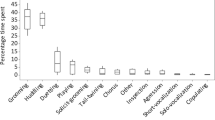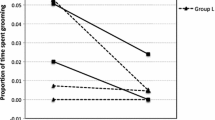Summary
-
1.
In nature, titi monkeys (Callicebus moloch) are typically found in small ‘family-type’ groups, the nucleus of which is an adult male and female that form strong and abiding emotional attachments to one another.
-
2.
To further understand the behavioral basis for this monogamous patern, the present experiment investigated the possibility that a mechanism tending to prevent accretions to the minimal male-female unit is ‘jealous behavior,’ defined as a specific set of spatial and agonistic responses occurring when a subject encounters its mate in proximity to a perceived competitor or rival. Ten adult titi monkeys housed in heterosexual pairs were observed in three sets of test conditions, one of which (Cagemate vs. Intruder) presented the subject's mate in three levels of increasing proximity to a stranger of the subject's sex (intruder). A parallel set of ‘control’ conditions (Opposite-Sex Stranger vs. Intruder) and three Single-Stimulus conditions were also presented. To provide comparative data on jealousy behavior in a nonmonogamous primate, ten adult squirrel monkeys (Saimiri sciureus) housed in malefemale pairs were tested in the same circumstances.
-
3.
Results from the jealousy conditions indicated a large, unanticipated sex difference in Callicebus. Male titis displayed a marked enhancement of attraction to the mate and an increment in agonism toward the intruder as a function of increasing proximity of intruder and mate (Fig. 3a). Female titis, however, showed an opposite reaction, displaying highest levels of attraction to the mate when the intruder was most distant (Fig. 3b). Neither sex of Saimiri showed significant jealousy reactions (Fig. 3c and d). Results from the Single-Stimulus conditions corroborated previous data indicating that basic attractions between male-female cagemates are both stronger and more specific in Callicebus than in Saimiri (Fig. 2).
-
4.
The sex difference in reactions to jealousy conditions found for titis in our experiment is consistent with available field notes on their behavior in the wild, and is interpreted in terms of the particular contingencies of male and female reproductive success in a monogamous social system. In particular, it is suggested that jealousy behavior in monogamous males reduces the likelihood of being cuckolded.
Similar content being viewed by others
References
Baldwin, J.D.: The social organization of a semifree-ranging troop of squirrel monkeys (Saimiri sciureus). Folia Primatol. (Basel) 14, 23–50 (1971)
Baldwin, J.D., Baldwin, J.I.: Squirrel monkeys (Saimiri) in natural habitats in Panama, Colombia, Brazil, and Peru. Primates 12, 45–61 (1971)
Baldwin, J.D., Baldwin, J.I.: The ecology and behavior of squirrel monkeys (Saimiri oerstedi) in a natural forest in western Panama. Folia Primatol. (Basel) 18, 161–184 (1972)
Coe, C.L., Rosenblum, L.A.: Sexual segregation and its ontogeny in squirrel monkey social structure. J. Hum. Evol. 3, 551–561 (1974)
Cubicciotti, D., III, Mason, W.A.: Comparative studies of social behavior in Callicebus and Saimiri: Male-female emotional attachments. Behav. Biol. 16, 185–197 (1975)
Kummer, H.: Social organization of hamadryas baboons. Bibliotheca Primatologica, No. 6, pp. 1–189. New York: Karger 1968
Kummer, H.: Dominance versus possession: An experiment on hamadryas baboons. In: Symp. IVth Int. Congr. Primat., Vol. 1: Precultural primate behavior (ed. E.W. Menzel, Jr.), pp. 226–231, Basel: Karger 1973
Kummer, H., Götz, W., Angst, W.: Triadic differentiation: An inhibitory process protecting pair bonds in baboons. Behaviour 49, 62–87 (1974)
Mason, W.A.: Social organization of the South American monkey, Callicebus moloch: A preliminary report. Tulane Stud. Zool. 13, 23–28 (1966)
Mason, W.A.: Use of space by Callicebus groups. In: Primates: Studies in adaptation and variability (ed. P.C. Jay), pp. 200–216. New York: Holt, Rinehart, and Winston 1968
Mason, W.A.: Field and laboratory studies of social organization in Saimiri and Callicebus. In: Primate behavior, Vol. 2: Developments in field and laboratory research (ed. L.A. Rosenblum), pp. 107–137. New York: Academic 1971
Mason, W.A.: Comparative studies of social behavior in Callicebus and Saimiri: Behavior of malefemale pairs. Folia Primatol. (Basel) 22, 1–8 (1974)
Mason, W.A.: Comparative studies of social behavior in Callicebus and Saimiri: Strength and specificity of attraction between male-female cagemates. Folia Primatol. (Basel) 23, 113–123 (1975)
Mason, W.A., Epple, G.: Social organization in experimental groups of Saimiri and Callicebus. In: Proc. 2nd Int. Congr. Primatol., Vol. 1, pp. 59–65, Basel: Karger 1969
Myers, J.L.: Fundamentals of experimental design. Second Edition. Boston: Allyn and Bacon 1973
Phillips, M.J., Mason, W.A.: Comparative studies of social behavior in. Callicebus and Saimiri: Social looking in male-female pairs. Bull. Psychonom. Soc. 7, 55–56 (1976)
Robinson, J.G.: Vocal regulation of spacing in the titi monkey Callicebus moloch. Ph.D. Dissertation, University of North Carolina 1977
Thorington, R.W., Jr.: Observations of squirrel monkeys in a Colombian forest. In: The squirrel monkey (eds. L.A. Rosenblum, R.W. Cooper), pp. 69–85. New York: Academic 1968
Trivers, R.L.: Parental investment and sexual selection. In: Sexual selection and the descent of man, 1871–1971 (ed. B. Campbell), pp. 136–179. Chicago: Aldine 1972
Vaitl, E.A., Mason, W.A., Taub, D.M., Anderson, C.O.: Contrasting effects of living in heterosexual paris and mixed groups on the structure of social attraction in squirrel monkeys (Saimiri). Anim. Behav. (in press) (1978)
Author information
Authors and Affiliations
Rights and permissions
About this article
Cite this article
Cubicciotti, D.D., Mason, W.A. Comparative studies of social behavior in Callicebus and Saimiri: Heterosexual jealousy behavior. Behav Ecol Sociobiol 3, 311–322 (1978). https://doi.org/10.1007/BF00296316
Received:
Issue Date:
DOI: https://doi.org/10.1007/BF00296316




